After doing a lot of research on Trip Advisor many months ago looking for a tour guide of Soweto, I had made arrangements for a highly recommended one, Booysie, to pick us up at the Apartheid Museum. For those unfamiliar with South African history, the vast township of Soweto was where the student anti-apartheid uprisings began.
An acronym for South West Townships, Soweto was founded in 1904, when city councilors used an outbreak of bubonic plague as an excuse to move black people outside of Johannesburg. About 12 miles south of downtown Johannesburg - often called Joburg and Jozi - Soweto is now officially part of Joburg, though during apartheid, they were regarded as poles apart. The suburb is home to about one million residents.
Just a short drive from the Apartheid Museum and Soweto was the 96,000 capacity FNB Stadium where the 2010 (Soccer) World Cup was held.

Booysie pointed out the gold tailings that bordered Soweto; they
were the materials or mine dumps left over after the process of separating the valuable mineral from the earth. As I wrote in the last post about the Apartheid Museum, men moved to work in the gold mines in Joburg from all over Africa and from other parts of the world in the latter half of the 19th century. Sadly, Booysie mentioned that this area was still a very toxic area and that nothing grows there. Because South Africa doesn't own the mines, the area remains an environmental disaster and its people must live with the results of the pollution.
were the materials or mine dumps left over after the process of separating the valuable mineral from the earth. As I wrote in the last post about the Apartheid Museum, men moved to work in the gold mines in Joburg from all over Africa and from other parts of the world in the latter half of the 19th century. Sadly, Booysie mentioned that this area was still a very toxic area and that nothing grows there. Because South Africa doesn't own the mines, the area remains an environmental disaster and its people must live with the results of the pollution.
Booysie was born in the early 50's into the apartheid system in Soweto. As he said, he lived there and thought all was normal as a child as that was all he knew. It was only as he grew up that he learned apartheid wasn't right. When his parents moved from Natal, southeast of Joburg, in the 1940s his father got a job as a driver for a clothing company but then joined the Traffic Department in the early 1950s just after apartheid was begun in 1948. As one of the first blacks assigned to control traffic, it was considered to be a very important job. He was unable, though, to fine a white person.
His mother was not educated but was able to give basic lessons to young children, Booysie said. He then told us about the Bantu education he and all black children had received. The 1953 Bantu Education Act was one of apartheid's most offensively racist laws. It brought African education under control of the government and extended apartheid to black schools. Previously, most African schools were run by missionaries with some state aid. But Bantu education ended the relative autonomy these schools had enjoyed up to that point. Instead, government funding of black schools became conditional on acceptance of a racially discriminatory curriculum administered by a new Department of Bantu Education.
What the African community vehemently opposed was the creation of a separate and unequal system of black education rather than a single public schooling system for all South Africans. Booysie explained that the Prime Minister questioned why a black child needed to learn math as he'd never need it. Likewise, black children only needed to learn enough English so they could speak to their bosses!
Racial equality was still a dream in South Africa, Booysie stated. Some whites were not happy with the changes made since the apartheid era. Just the preceding week, two white men had tried to bury a black man in a coffin. Some blacks weren't happy either, he said, believing they should fight back as they needed to do something because of the ongoing racial tensions.
People (he didn't specify whether he meant black or white but I think he meant blacks) began to turn their backs on the African National Congress (ANC) since 2009. The ANC has been the ruling party of post-apartheid South Africa on the national level, beginning with the election of Nelson Mandela in the 1994 election, the first election after the end of apartheid. The reason for the profound concern on the part of many people is the level of fraud and corruption happening at the top with the current ANC President, Jacob Zuma, according to Booysie.
The Democratic Alliance or DA was a political party representing whites when it started but it changed over time to having black leadership. The DA, now led by a young man from Soweto, is the official opposition party to the governing ANC. The cities of Joburg, Capetown, Pretoria and Port Elizabeth are all under DA control.
All but one of the colors in the country's flag were represented in the Soweto sign: the red was from the blood lost during the wars; the blue symbolized the sky and sea bordering so much of the country; the green was the link to the country's vegetation; the black represented the black people and the gold was for the country's minerals. White was the only color missing from the sign but is part of the flag; it represents the country's white people. I could see why it was not included as part of the Soweto sign!
People (he didn't specify whether he meant black or white but I think he meant blacks) began to turn their backs on the African National Congress (ANC) since 2009. The ANC has been the ruling party of post-apartheid South Africa on the national level, beginning with the election of Nelson Mandela in the 1994 election, the first election after the end of apartheid. The reason for the profound concern on the part of many people is the level of fraud and corruption happening at the top with the current ANC President, Jacob Zuma, according to Booysie.
The Democratic Alliance or DA was a political party representing whites when it started but it changed over time to having black leadership. The DA, now led by a young man from Soweto, is the official opposition party to the governing ANC. The cities of Joburg, Capetown, Pretoria and Port Elizabeth are all under DA control.
All but one of the colors in the country's flag were represented in the Soweto sign: the red was from the blood lost during the wars; the blue symbolized the sky and sea bordering so much of the country; the green was the link to the country's vegetation; the black represented the black people and the gold was for the country's minerals. White was the only color missing from the sign but is part of the flag; it represents the country's white people. I could see why it was not included as part of the Soweto sign!
Before this tour, Steven and I had always thought of Soweto as having exclusively slums, so when Booysie drove us first to this very attractive middle class area of Soweto, our jaws dropped as it didn't match our stereotypes.
Right across the street from these homes was this high school but Booysie explained it was not supported by the black residents because its facilities were not seen as being the best.
Booysie told us that there are only a smattering of whites in all of Soweto. The blacks, he said, are waiting for whites to move in but the whites were still afraid wondering how blacks would receive them. On hearing that, I wondered not only if and when this impasse will pass but what would be the catalyst for change.
In 1986-87, nicer homes like these were built when companies like IBM bought land for their employees and other people then bought in the area too. Most of the residents, he said, now were professionals and businessmen. A good number of the homes we saw had fences surrounding their homes but there wasn't any barbed wire at the top.
There were a considerable number of B&B's in the neighborhood.
From that idyllic-looking area of Soweto, Booysie drove only a few miles to Mzhimhlope Men’s Hostel, built by the government many decades previously for men who had come to work during the week in Joburg. On the weekends, they visited their families in the rural areas.
There are still 12 hostels just like this one around Joburg, he said. The men live in deplorable conditions. The ANC tried to renovate them and turn them into family units but that never happened.
Next to the hostel were these town houses that were built also by the government but so many were vandalized, they were never occupied. Booysie described it as another waste of government money.
If the government weren't corrupt, he stated, people would be moving in. Corruption was a major problem in so much of South Africa, Booysie told us: you had to bribe an official to buy a house and also with many other facets of daily life. Corruption starts with the president and trickles down to local government officials. It was eye opening hearing first hand how terrible the situation was there. It reminded us how lucky we are to live in the US, even with its many problems.
This was still part of the huge men's hostel.
This was still part of the huge men's hostel.
Booysie described these homes as being in an area of old Soweto. The homes were standing empty so squatters have moved in.
Booysie explained that it wasn't considered stealing when laundry was taken from the fence but rather 'shopping online'!
A short distance away, Booysie described this as a 'typical' four room home in Soweto.
The house next door had been the same until it had been added on both in the front and back.
On the way to our first stop, Orlando Towers, we passed the Chris Hani Hospital which had 4,000 beds and served all of South Africa, Booysie said. It was named for Hani, a fierce opponent of the apartheid government, who was assassinated in 1993.
The brightly painted Orlando Towers complex in Soweto is a well-known landmark in Joburg. The towers were originally a coal-fired power station built in the 1940s to supply electricity to the residents of Joburg but not Soweto even though it was located there. The towers were decommissioned in 1998 after 56 years of service and were painted by a sign company in early 2000.
The brightly painted Orlando Towers complex in Soweto is a well-known landmark in Joburg. The towers were originally a coal-fired power station built in the 1940s to supply electricity to the residents of Joburg but not Soweto even though it was located there. The towers were decommissioned in 1998 after 56 years of service and were painted by a sign company in early 2000.
In 2006, work was started to transform the site of the power station into an adrenaline junkie's paradise for those adventurous enough to want to go bungee and base jumping from the top of the 33 story structure! I loved hearing that the towers were used for a Fast Forward on the seventh season of The Amazing Race, my all time favorite TV show! The contestants had to to walk across a suspension bridge 30 ft above the ground between the power station's towers.
It's safe to say that neither Steven nor I were willing to do the 300 plus feet free fall inside the tower nor the bungee jump outside!
As we drove next to Kliptown, Booysie mentioned it was the oldest residential district of Soweto and was first laid out in 1891. He said it was the least developed area of Soweto and that its residents feel neglected there. Blacks and Asians live in Kliptown, he said, as demand for housing is so great there because of its proximity to Joburg. Nine tribes live in Kliptown and Booysie said he has was able to speak seven of those languages because he lived with the people side by side.
Once we arrived in Kliptown, Booysie mentioned, much to our surprise/dismay, that he had arranged a tour of the area with a local and that he would pick us up about an hour later! Voss, our new guide, said the four star hotel below was located near his community which turned out be literally 'across the tracks.'
In a large park-like area by the hotel called Walter Sisulu Square, Voss showed us and another couple this monument that represented the long lines it took to vote in 1955.
It was very moving reading the dedication:
Voss next showed us, in the same square, the Freedom Charter Monument where people from Kliptown had come together to create a wish list for all people to be treated equal. In June, 1955, Kliptown was the home of an unprecedented Congress Alliance, a gathering of political and cultural groups trying to map a way forward during the repressive 1950s.
This Congress saw the declaration and adoption of the Freedom Charter which set out the aims and aspirations of the opponents of apartheid. The Charter was characterized by its opening demand, 'The People Shall Govern!' The Freedom Charter's significance in South Africa is similar to that of the Declaration of Independence. It influenced South Africa's new constitution, adopted in 1995, and is widely considered to be one of the best and most progressive in the world.
This Congress saw the declaration and adoption of the Freedom Charter which set out the aims and aspirations of the opponents of apartheid. The Charter was characterized by its opening demand, 'The People Shall Govern!' The Freedom Charter's significance in South Africa is similar to that of the Declaration of Independence. It influenced South Africa's new constitution, adopted in 1995, and is widely considered to be one of the best and most progressive in the world.
Voss said that only 35% of the Freedom Charter has been adopted.
Also in Sisulu Square was one of South Africa's three Parliaments; the other two are in Pretoria and Capetown. Voss said this one was more of a showpiece as government representatives rarely meet at the Kliptown location.
A two minute walk from Parliament and the lofty ideals expressed in the Freedom Charter Monument was the residential area of Kliptown. Voss mentioned that the suburb's population was 45,000 and unemployment was 55% although others report it as high as 72%. Other major issues in Kliptown, he said, were HIV/AIDS, drugs, alcohol and high rates of crime. Our first view of Kliptown over the metro tracks was what I certainly had imagined all of Soweto would look like.
I can only hope that these pictures tell a thousand words as the degree of poverty was almost overwhelming and very depressing.
The painting or mural was done by students at the university level, according to Voss.
Voss was born and bred in Kliptown and still lived there. Here he was with a Dutch couple who had also joined us on the tour of Kliptown. He talked about his community's needing to break the cycle of absolute poverty and questioned what his fellow South Africans are doing as individuals to understand the lives of people in Kliptown.
I was apprehensive walking around in Kliptown, not because of any concerns with our safety, but for what kind of reception we could expect from people. I could only imagine they must be thinking here's yet another group of white tourists coming to look 'at' them in their poverty. Yes, we did get some stares but we weren't made to feel unwelcome, I thought.
Voss said that he and other 'activists' have convinced residents in Kliptown that it was okay to steal electricity from the government. After all, he said, politicians make a point of coming round every election period and making all sorts of promises to the residents and never follow through on any of them. Therefore, people 'decided to fight back and teach government a lesson' by taking matters into their own hands as he said.
It's normal for residents in Kliptown to share almost everything; for instance, if some people are hungry, they know they are always welcome to eat with others who have food at that time. This was a common toilet shared by ten families.
This was what passed as Kliptown's 'sewer system'. Not surprisingly, chicken pox and other childhood diseases are rife as children eat without washing their hands.
Voss showed us his home next. This small kitchen was somehow turned into a bedroom at night and accommodated 23 people.
As far as we noticed, his home only consisted of the kitchen and this room off it - nothing else at all.
The leaky roof provided a free shower when it rained, Voss said, in a half joking tone.
When we entered his home, a couple of toddlers were playing on the floor but we didn't see anyone else around.
Bed springs had been recycled and were used as a fence.
The communal water tap:
Voss also talked positively about the Democratic Alliance and how it was regarded by many in Kliptown as the new African National Congress in the sense of the high ideals the latter had started out with.
Walking among the Kliptown residents and their homes and seeing first hand their living conditions had been shocking and heart breaking, all the more so, I think, as it was so close to a city of much wealth.
We then got picked up again by Booysie who showed us some of Soweto's middle class homes. What we just saw was obviously the poorest part of Soweto.
Nelson Mandela and Steve Biko, two of the main anti-apartheid leaders:
Soweto's Regina Mundi Catholic Church played a pivotal role in the struggle against apartheid in the second half of the 20th century, Booysie said. Since political meetings in most public places were banned, the church became the main place where Soweto people could meet and discuss issues. Even funerals often ended up as political meetings. That was why the church earned the reputation of being one of the main centers of anti-apartheid activism in the entire province. Archbishop Desmond Tutu often delivered sermons in this massive church - it accommodated up to 6,000 people - during the apartheid years.
During the Soweto uprising of June 16, 1976, many demonstrators fled to Regina Mundi. The police entered the church, firing live ammunition. No one was killed, although many were injured and the church itself, as well as its furniture, decorations and religious symbols, were damaged. Steven and I were so disappointed that Booysie had not made this our first stop on our Soweto tour as the church was closed when we arrived.
During the Soweto uprising of June 16, 1976, many demonstrators fled to Regina Mundi. The police entered the church, firing live ammunition. No one was killed, although many were injured and the church itself, as well as its furniture, decorations and religious symbols, were damaged. Steven and I were so disappointed that Booysie had not made this our first stop on our Soweto tour as the church was closed when we arrived.
Booysie took us next to the Hector Pieterson Memorial. On June 16, 1976, school children like Hector Pieterson protested the implementation of Afrikaans and English as dual medium of instruction in secondary schools on a 50:50 basis. This was implemented throughout South Africa regardless of the locally-spoken language. Students gathered to peacefully demonstrate, but the crowd soon became very aggressive when the police arrived. Students then started to throw stones and the police retaliated, shooting first one student before killing Pieterson.
Thirteen year old Pieterson became the subject of an iconic image of the 1976 Soweto uprising when a news photograph of the dying Hector being carried by another student while his sister ran next to them, was published around the world.
The photographer, Sam Nzima, was arrested as he had exposed the horrors of apartheid to the outside world. Booysie said South Africa was expelled from the 1976 Montreal Olympics because of that photo. The student who had carried Hector was harassed by the police and had to leave South Africa for his own safekeeping.
Thirteen year old Pieterson became the subject of an iconic image of the 1976 Soweto uprising when a news photograph of the dying Hector being carried by another student while his sister ran next to them, was published around the world.
The photographer, Sam Nzima, was arrested as he had exposed the horrors of apartheid to the outside world. Booysie said South Africa was expelled from the 1976 Montreal Olympics because of that photo. The student who had carried Hector was harassed by the police and had to leave South Africa for his own safekeeping.
For years, June 16th stood as a symbol of resistance to the brutality of the apartheid government. Today, it is designated Youth Day when South Africans honor young people and bring attention to their needs.
A very good explanation for the student uprising:
The water in the Memorial symbolized the tears shed by the parents whose children were hurt in the uprising. The rock wall represented the rocks thrown by the school children at the police, according to Booysie. The rocks came from Robben Island where Nelson Mandela was imprisoned for so many years. (Our tour of Robben Island will be the subject of a future post.)
An accounting by witnesses of what happened on June 16th, 1976:
Sculptures representing what transpired during the student uprising:
This showed one of the police officers with one of the ferocious dogs that, when released into the crowd of students, caused utter panic. Booysie mentioned that few people in Soweto owned dogs as they were always associated with police violence.
Hector Pieterson was shot at this location on the corner of Vilakazi St, while he was just walking home from one of the several high schools on the street. According to Booysie, Hector was not involved in the student protests at all, but was just tragically an innocent bystander.
Vilakazi St., the street where the uprising took place, is one of the most famous streets in Soweto as it's also the only street in the world where two Nobel Peace Prize winners lived: Nelson Mandela and Desmond Tutu.
This was one of the several high schools we saw on the four or five block long Vilakazi St. Booysie mentioned that when he went to school there, there were 67 students in his class. How could anyone be expected to learn under those conditions, let alone teach?
We were only unfortunately able to see the outside of Nelson Mandela's home which had been turned into a museum as again Booysie had taken us here too late. Mandela lived here until his arrest in 1962 and then from 1990 onwards after his release from prison.
Booysie remarked that South Africans never knew what was going on in their own country during much of the apartheid era because there was so much censorship. People would go to jail if in possession of printed materials. All the photos and information in the Mandela Museum came from abroad. Booysie added it was only in recent years that he was was able to discover what happened in his own country during that era.
Just a couple of blocks away on Vilakazi St. behind the wall was Archbishop's Desmond Tutu's house .
Directly across from Tutu's house was this restaurant and bar - it can't be easy for the Archbishop, who is in failing health, to sleep through this bar and all the others up and down Vilakazi St.!
On the way to the metro station where we caught the Gautrain back to near the Blue Mango Lodge, Booysie expressed pride in Soweto now as it was so much nicer, in his words, than it was when he had grown up there. He credited the improvement to what many residents in certain parts of the township had done to improve their homes and lives. Booysie made clear none of that was because of any help from the government.
As we drove passed the Orlando Towers again, he said that they illustrated the ordinary life of Soweto now with the train running right through it and the Soweto string quartet. Also pictured on the Towers was the world famous South African civil rights activist and musician, Miriam Makeba.
It would be impossible to describe our visit to the Apartheid Museum and subsequent tour of Soweto as uplifting experiences. However, I feel that our visit to Johannesburg would certainly have been incomplete without seeing both as we gained a greater understanding of a horrific part of South Africa's history.
Posted on January 8th, 2016 from Littleton, Colorado.



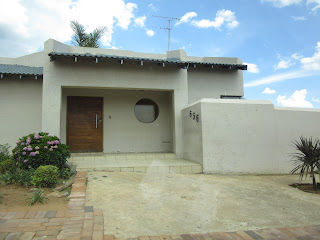


























































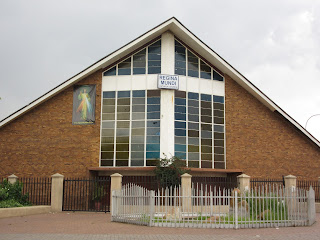

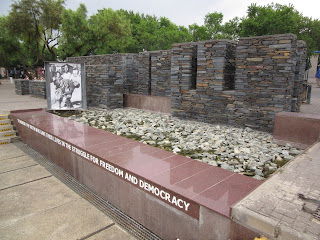




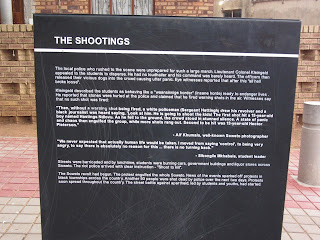
















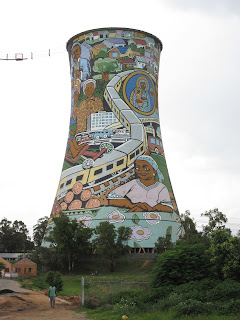

No comments:
Post a Comment
We love to hear from you!!!!